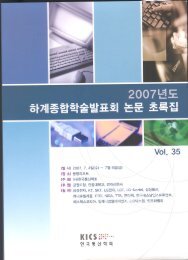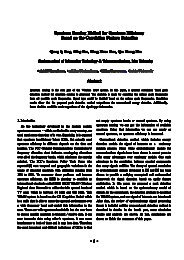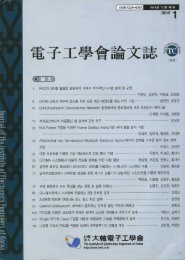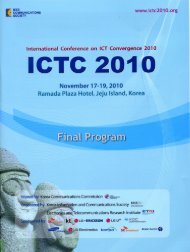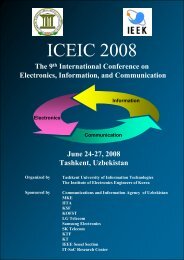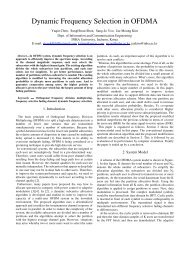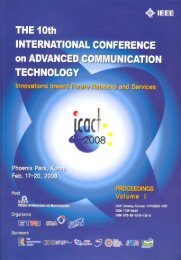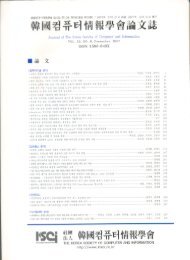Untitled
Untitled
Untitled
Create successful ePaper yourself
Turn your PDF publications into a flip-book with our unique Google optimized e-Paper software.
A partial cyclic prefix based method for frequency offset estimation with<br />
robustness against symbol timing offset<br />
Ning Han Soung-Hwan Shon Jae-Moung Kim<br />
neil_han@hotmail.com, kittisn@naver.com, jaekim@inha.ac.kr<br />
Graduate school of Information Technology & Telecommunications Inha University<br />
Abstract<br />
In this paper, we propose an improved method based on J.J. van Beek algorithm to estimate the frequency offset<br />
in OFDM systems. The improved estimation method uses part of the cyclic prefix, therefore, by carefully choosing<br />
the length of CP, it has good robustness against symbol timing offset, at the same time, the estimation accuracy can be<br />
guaranteed. Simulation results show that the mean-squared error (MSE) can be significantly improved at high Eb/N0<br />
level with the proposed method compared with the conventional one.<br />
Ⅰ. Introduction<br />
Orthogonal frequency division multiplexing (OFDM) is an<br />
effective transmission technology to combat multipath fading,<br />
by circular copying the last part of the symbol as the prefix, the<br />
inter-symbol interference (ISI), as well as the inter-carrier<br />
interference (ICI) can be mitigated.<br />
OFDM systems are very sensitive to carrier frequency offset<br />
and even a small frequency offset can greatly degrade the<br />
performance of the OFDM receiver [1]. There are two kinds of<br />
frequency offset estimation algorithms, data-aided and<br />
non-data-aided. Many data-aided estimators rely on the<br />
periodical transmission of known data blocks to correct the<br />
carrier frequency offset [1-4]. These estimators ensure fast and<br />
reliable synchronization, but they reduce system resource<br />
utilization. Blind estimation and cyclic prefix based estimation<br />
algorithm are non-data-aided, but blind estimation increases the<br />
system complexity greatly. J.J. van Beek proposed a method to<br />
estimate fractional frequency offset in time domain. It uses the<br />
redundant information contained within the cyclic prefix [5].<br />
In this paper, an improved fractional frequency offset<br />
estimation method is proposed which uses just part of the CP<br />
length. Compared to J. J. van Beek algorithm, the proposed<br />
scheme has almost the same estimation accuracy, but higher<br />
robustness against symbol timing offset.<br />
The remainder of this paper is organized as follow. SectionⅡ<br />
briefly introduces the OFDM fundamentals. SectionⅢ presents<br />
the improved carrier frequency offset estimation method. Some<br />
simulation results follows in sectionⅣ. At last, some conclusions<br />
are drawn in sectionⅤ.<br />
Ⅱ. OFDM System Model<br />
OFDM input signals are complex numbers of some signal<br />
constellation (e.g., PSK, QAM). Let X(k) denotes complex signal<br />
modulated on to the k-th subcarrier. The output signal samples, x(n)<br />
can be found by an Inverse Discrete Fourier Transform (IDFT) of<br />
X(k), as given by:<br />
x<br />
1 N<br />
N<br />
∑ −1<br />
k = 0<br />
( n ) = X ( k )<br />
e<br />
π n=0, 1, 2,…, N-1 (1)<br />
j 2 kn / N<br />
After that, the last L samples of x(n) are copied and put as a<br />
preamble (Cyclic Prefix) to form one OFDM Symbol. The length<br />
L of cyclic prefix should be longer than the channel impulse<br />
response, in order to avoid ISI.<br />
Then, passing x(n) through the channel, we obtain the complex<br />
received signals as given by:<br />
y<br />
N<br />
= ∑ −1<br />
j 2π ( k + ε ) n / N<br />
( n)<br />
X ( k ) H ( k ) e + w(<br />
n)<br />
k = 0<br />
n=-L, - (L-1), … , 0, 1, 2, … , N-1 (2)<br />
where H(k) is a complex transfer function of the channel at the<br />
frequency of the k-th subcarrier, ε is the frequency offset<br />
normalized to the subcarrier spacing, and w(n) denotes the<br />
samples of the complex envelope of AWGN. The corresponding<br />
baseband signal is given by:<br />
y<br />
j2π<br />
nε<br />
/ N<br />
( n)<br />
= x(<br />
n)<br />
e + w(<br />
n)<br />
(3)
The received samples, after the cyclic prefix is removed, can be<br />
turned into the estimate, Y(k), of the transmitted signals, X(k), by<br />
a Discrete Fourier Transform (DFT) , given by:<br />
Y<br />
1<br />
N<br />
N 1<br />
π<br />
− j 2 nk / N<br />
( k ) y(<br />
n ) e + W ( k )<br />
= ∑ −<br />
n = 0<br />
k=0, 1, 2, … , N-1 (4)<br />
a). J.J. van Beek algorithm:<br />
Ⅲ. Frequency offset estimation<br />
The conventional J.J. van Beek algorithm uses the cyclic<br />
property of the CP and the correlation length is L which is the<br />
length of CP. The performance can be guaranteed if no symbol<br />
timing errors occur. The symbol structure is shown in Fig.1:<br />
Fig.1. OFDM symbol structure for J.J. van Beek algorithm, no<br />
symbol timing offset<br />
Therefore, the frequency offset can be estimated as given by:<br />
∧ 1<br />
ε = − ∠ γ ( m )<br />
(5)<br />
2π<br />
Where the parameter m denotes the symbol timing offset, γ ( m)<br />
is<br />
the correlation function, given by:<br />
γ<br />
∑ − + m L 1<br />
n = m<br />
∗<br />
( m ) = y(<br />
n ) y ( n + N )<br />
∧<br />
We can find that the estimated offset depends on the symbol<br />
timing offset number m.<br />
When symbol timing errors occur, the colored part (as shown in<br />
Fig.1) named as moving sum window for correlation moves<br />
backward (as shown in Fig.2).<br />
Fig.2. OFDM symbol structure for J.J. van Beek algorithm,<br />
ε<br />
symbol timing offset number is m.<br />
The first part maintains the cyclic property, but rests of the moving<br />
window losses this property. This is the reason why the<br />
(6)<br />
performance is poor when symbol timing errors occur.<br />
Simulations in AWGN and Rayleigh fading channel are made.<br />
(as shown in Fig.3)<br />
Simulation result shows, that if the previous timing estimation<br />
procedure is accurate or there is no symbol timing offset, the<br />
performance of this algorithm is good (Fig.3). But the<br />
performance decreases rapidly even small number of symbol<br />
timing errors occur. Fig.4 shows the performance degradation in<br />
both AWGN and Rayleigh fading channel as a function of symbol<br />
timing offset. Even the Eb/N0 value is large, the performance<br />
degrades rapidly when the symbol timing errors increases to about<br />
40 samples.<br />
MSE<br />
MSE<br />
1.00E+00<br />
1.00E-01<br />
1.00E-02<br />
1.00E-03<br />
1.00E-04<br />
1.00E-05<br />
1.00E-06<br />
1.00E-07<br />
1.00E-08<br />
1.00E-09<br />
AWGN Channel<br />
Rayleigh Fading Channel<br />
0 3 6 9 12 15 18 21 24 27 30 33 36 39 42 45 48 51<br />
Eb/N0<br />
Fig.3. MSE versus En/N0 for the J.J van Beek algorithm in<br />
1.0E+00<br />
1.0E-01<br />
1.0E-02<br />
1.0E-03<br />
1.0E-04<br />
1.0E-05<br />
1.0E-06<br />
1.0E-07<br />
AWGN and Rayleigh fading channel.<br />
AWGN 0dB<br />
AWGN 25dB<br />
Rayleigh Fading 25dB<br />
0 4 8 12 16 20 24 28 32 36 40 44 48 52 56 60 64 68 72 76 80 84 88 92 96<br />
Symbol Timing Offset<br />
Fig.4. MSE versus Symbol timing offset for the J.J van Beek<br />
algorithm in AWGN and Rayleigh fading channel.<br />
b). Proposed method<br />
We propose an improved method to estimate the frequency<br />
offset by using part of the CP length. When symbol timing offset<br />
occurs, the OFDM symbol structure of the proposed method is
shown below.<br />
Fig.5. OFDM symbol structure for the proposed method,<br />
symbol timing offset number is m.<br />
The corresponding correlation function is given by:<br />
∑ − + m β L 1<br />
n = m<br />
∗<br />
( m ) = y(<br />
n ) y ( n + N )<br />
γ (7)<br />
Whereβis the CP used rate. It could be 1/2, 1/4 and even 1/8.<br />
We can find that as the moving sum window length decreases, the<br />
cyclic property can be maintained. When the moving sum window<br />
boundary does not extend beyond the CP length, good<br />
performance can be guaranteed.<br />
As the CP used rate β decreases, the moving sum window<br />
length decreases ( βL in (7)), therefore the estimation accuracy<br />
gets worse. The results can be proved by the simulation results in<br />
the following section.<br />
Ⅳ. Computer simulations<br />
An outdoor dispersive, fading environment is selected and<br />
modeled as a channel consisting of 6 independent Rayleigh fading<br />
paths. The maximum vehicle speed is 100 km/h. The total<br />
subcarrier number is 2048. A cyclic prefix with length of 128 is<br />
used. The proposed method can be realized by the following<br />
structure (Fig.6).<br />
Fig.6. Implementation structure of the proposed method.<br />
We first assumed that frequency offset is 0.38, and symbol timing<br />
offset is 50 samples, comparing the mean-squared error (MSE)<br />
performance of the improved method with the conventional<br />
algorithm in AWGN channel with different Eb/N0 value.The<br />
parameterβis set to 1 for the J.J van Beek algorithm, and 1/2, 1/4,<br />
1/8 for the improved method respectively. Fig.7 shows the<br />
performance.<br />
MSE<br />
1.00E+00<br />
1.00E-01<br />
1.00E-02<br />
1.00E-03<br />
1.00E-04<br />
1.00E-05<br />
1.00E-06<br />
1.00E-07<br />
1.00E-08<br />
1.00E-09<br />
0<br />
4<br />
8<br />
12<br />
16<br />
20<br />
24<br />
28<br />
Eb/N0<br />
32<br />
36<br />
40<br />
44<br />
β= 1<br />
β= 1/2<br />
β= 1/4<br />
β= 1/8<br />
Fig.7. MSE versus Eb/N0 performance for the comparison of the<br />
improved method and the J.J Van Beek algorithm in AWGN<br />
channel with 50 samples symbol timing offset<br />
In Fig.7, when symbol timing error occurs, increasing the<br />
Eb/N0 value can not improve the performance for the<br />
conventional J.J van Beek algorithm. But, it has a different result<br />
for the proposed method. As the Eb/N0 value increasing the<br />
performance increases linearly.<br />
The performance of the proposed method in fading channel is<br />
shown below in Fig.8. As the fading path number increasing, the<br />
distortion caused by the delayed paths increase, therefore, the<br />
performance of 2-path fading is better than that of 6-path.<br />
MSE<br />
1.00E+00<br />
1.00E-01<br />
1.00E-02<br />
1.00E-03<br />
1.00E-04<br />
1.00E-05<br />
1.00E-06<br />
1.00E-07<br />
1.00E-08<br />
1.00E-09<br />
1.00E-10<br />
0 3 6 9 12 15 18 21 24 27 30 33 36 39 42 45 48 51<br />
Eb/N0<br />
48<br />
β=1/4 6-path<br />
β=1/4 2-path<br />
β=1/2 6-path<br />
β=1/2 2-path<br />
Fig.8. MSE versus Eb/N0 performance for the improved method<br />
in 2-path and 6-path Rayleigh fading channel with 50 samples<br />
symbol timing offset and differentβvalue<br />
Then we assumed that the frequency offset is 0.38, comparing<br />
the robustness of the proposed method with the conventional<br />
algorithm in both AWGN and Rayleigh fading channel.<br />
Fig.9, .10, .11 show the simulation results.
MSE<br />
1.0E+00<br />
1.0E-01<br />
1.0E-02<br />
1.0E-03<br />
1.0E-04<br />
β= 1<br />
β= 1/2<br />
β= 1/4<br />
β= 1/8<br />
0 9 18 27 36 45 54 63 72 81 90 99 108 117 126 135 144<br />
Symbol Timing Offset<br />
Fig.9. MSE versus Symbol Timing Offset performance in AWGN<br />
MSE<br />
1.0E+00<br />
1.0E-01<br />
1.0E-02<br />
1.0E-03<br />
1.0E-04<br />
1.0E-05<br />
1.0E-06<br />
channel with Eb/N0 equals to 0dB.<br />
β= 1<br />
β= 1/2<br />
β= 1/4<br />
β= 1/8<br />
0 9 18 27 36 45 54 63 72 81 90 99 108 117 126 135 144<br />
Symbol Timing Offset<br />
Fig.10. MSE versus Symbol Timing Offset performance in<br />
AWGN channel with Eb/N0 equals to 20dB.<br />
In Fig.9, the proposed method performs not stably. As the<br />
Eb/N0 value increases, as shown in Fig.10, the proposed method<br />
has a better performance, and even in Rayleigh fading channel the<br />
proposed method has a good robustness against symbol timing<br />
offset, as shown in Fig.11. We can also find that as the CP used<br />
rate β decreases, the proposed method have better robustness<br />
against symbol timing offset, but the accuracy decreased only a<br />
little.<br />
All the simulation results prove our analysis in the previous<br />
section. The proposed method does have the robustness against,<br />
and the estimation accuracy can be guaranteed at the same time.<br />
Ⅴ. Conclusions<br />
In this paper, an improved method of frequency offset<br />
estimation is proposed, based on the conventional J.J. van Beek<br />
algorithm, which utilizes the correlation property of the cyclic<br />
prefix in the time domain.<br />
MSE<br />
1.0E+00<br />
1.0E-01<br />
1.0E-02<br />
1.0E-03<br />
1.0E-04<br />
1.0E-05<br />
1.0E-06<br />
1.0E-07<br />
1.0E-08<br />
β= 1<br />
β= 1/2<br />
β= 1/4<br />
β= 1/8<br />
0 9 18 27 36 45 54 63 72 81 90 99 108 117 126 135 144<br />
Symbol Timing Offset<br />
Fig.11 MSE versus Symbol Timing Offset performance in<br />
Rayleigh fading channel with Eb/N0 equals to 25dB.<br />
The proposed method utilizes part of the CP length; therefore, it<br />
is robust against the symbol timing offset. Simulation results<br />
shows the robustness depends on the CP used rate β. Also, the<br />
accuracy decreases a little bit as β decreases. We think this method<br />
can be implemented in the situation that small number of symbol<br />
timing errors occurs, or after the symbol timing offset estimation.<br />
Future work should focus on the forward symbol timing<br />
estimation researching and a data-aided method study to guarantee<br />
higher estimation accuracy.<br />
This research was supported by University IT Research Center<br />
Project (INHA UWB-ITRC), Korea<br />
References<br />
[1] P. H. Moose, “A technique for orthogonal frequency division<br />
multiplexing frequency offset correction,” IEEE Trans. Comm.,<br />
vol. 42, pp. 2908–2914, October 1994.<br />
[2] M. Morelli and U. Mengali, “An improved frequency offset<br />
estimator for OFDM applications,” IEEE Commun. Lett., vol.<br />
3, pp. 75–77, March 1999.<br />
[3] M. Louise and R. Reggiannini, “Carrier frequency acquisition<br />
and tracking for OFDM systems,” IEEE Trans. Commun., vol.<br />
44, pp. 1590–1598, November 1996.<br />
[4] T. M. Schmidl and D. C. Cox, “Robust frequency and timing<br />
synchronization for OFDM,” IEEE Trans. Commun., vol. 45, pp.<br />
1613–1621, December 1997.<br />
[5] J. J. van de Beek, M. Sandell, and P. O. Borjesson, “ML<br />
estimation of time and frequency offset in OFDM systems,”<br />
IEEE Trans. Signal Processing, vol. 45, pp. 1800–1805, July<br />
1997.



